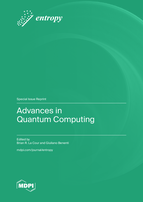Advances in Quantum Computing
A special issue of Entropy (ISSN 1099-4300). This special issue belongs to the section "Quantum Information".
Deadline for manuscript submissions: closed (15 September 2023) | Viewed by 50967
Special Issue Editors
Interests: quantum information science; quantum optics; quantum-inspired technologies; quantum foundations; signal and information processing; underwater acoustics
Interests: thermoelectric transport; heat transport and thermal rectifiers; far from equilibrium quantum systems; quantum computation and quantum information; open quantum systems; many-body quantum systems; disordered systems; nonlinear and complex systems
Special Issues, Collections and Topics in MDPI journals
Special Issue Information
Dear Colleagues,
The field of quantum information science has seen tremendous progress over the last several years, with advances in both hardware development and novel algorithms. Already, there have been several claims to the demonstration of quantum computational advantage, in both matter-based and photonic devices, and new large-scale systems promise to soon provide a practical advantage over classical digital processors in real-world applications. Nevertheless, some of the early demonstrations of quantum advantage have more recently been challenged by new classical methods that can mimic the noisy and imprecise nature of realistic quantum devices. The future viability of quantum computers now appears to rely on demonstrating two key features: (1) that they are fundamentally distinct and more capable than classical devices, and (2) that they are practically scalable in the number of qubits.
This Special Issue focuses on the recent advances, and challenges, in developing large-scale, fault-tolerant quantum computers capable of solving tomorrow’s growing computational needs. Original unpublished papers and review articles are invited on the following topics: (1) advances in quantum computing hardware, (2) novel quantum and hybrid algorithms, (3) applications to real-world problems using noisy, intermediate-scale quantum devices, (4) quantum networks and distributed quantum computing, (5) classical challenges to demonstrations of quantum advantage, and (6) investigations into the scalability of different quantum hardware architectures.
Dr. Brian R. La Cour
Dr. Giuliano Benenti
Guest Editors
Manuscript Submission Information
Manuscripts should be submitted online at www.mdpi.com by registering and logging in to this website. Once you are registered, click here to go to the submission form. Manuscripts can be submitted until the deadline. All submissions that pass pre-check are peer-reviewed. Accepted papers will be published continuously in the journal (as soon as accepted) and will be listed together on the special issue website. Research articles, review articles as well as short communications are invited. For planned papers, a title and short abstract (about 100 words) can be sent to the Editorial Office for announcement on this website.
Submitted manuscripts should not have been published previously, nor be under consideration for publication elsewhere (except conference proceedings papers). All manuscripts are thoroughly refereed through a single-blind peer-review process. A guide for authors and other relevant information for submission of manuscripts is available on the Instructions for Authors page. Entropy is an international peer-reviewed open access monthly journal published by MDPI.
Please visit the Instructions for Authors page before submitting a manuscript. The Article Processing Charge (APC) for publication in this open access journal is 2600 CHF (Swiss Francs). Submitted papers should be well formatted and use good English. Authors may use MDPI's English editing service prior to publication or during author revisions.
Keywords
- quantum computing
- quantum networks
- dequantization
- quantum advantage
- nisq device
- quantum mechanics
- physics
- algorithms
- hardware
- scalability








